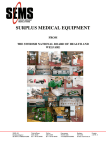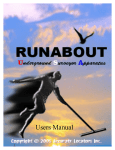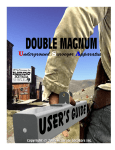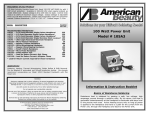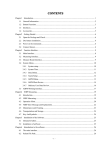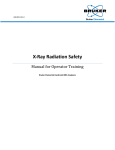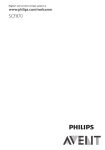Download SWEDE Trainers´s Guide Decon Unit
Transcript
SWEDISH EMERGENCY DISASTER EQUIPMENT INSTRUCTION MANUAL Cargo Decontamination Unit Version III TRAINER’S GUIDE PHOTO These instructions must be followed carefully. Only those persons who have been properly trained in the deployment of the unit should be allowed to set up and operate the Cargo Decontamination Unit Version III. Further, only certified and approved personnel should be permitted to service and maintain the unit. DECONTAMINATION PRODUCTS FOR NUCLEAR, BIOLOGICAL & CHEMICAL EMERGENCIES START UP v Prepare for the training session by placing the trailer near a source of water, ideally, a fire hydrant. This may require permission from or coordination with the local fire department. Ensure that the front and rear compartments are unlocked and that the items inside have not shifted around during transport. v Greet the class and introduce yourself. Ask the class members if they know each other – ask them to introduce themselves if not. v Ask the class to share what they know about decontamination – why, how, where, etc. Ask them how decontaminating things might differ from decontaminating people, especially those who are injured or suffering the effects of a chemical, biological, or radiological event. v Present the Decontamination Concept. Include the following: § Background – Chernobyl/Tokyo Subway Event, possible impact on medical treatment systems § Why, when, where, how § Correlation between Decontamination Unit and Personal Protective Equipment v Emphasize that the unit is self-contained…you just add water. v Move class to front of trailer and explain that the trailer is always positioned with the front of the trailer (the end with the tow hitch) toward the contamination site. This becomes the “dirty” end of the trailer. v Point out each of the features on the front of the trailer (main electric connector, main water valve, water in and out, electric pump connectors) and their purpose. 2 START UP v Open the front compartment and describe the items contained therein. Have class remove any non-system items and move them to a “safe” location. Ask the class for what they believe would be a safe location. Discuss the impact of storing non-system items in the unit versus set up times. v Move class to side of trailer. Again, point out the different fixtures (lights, mounting brackets, heater door, thermostat, etc.) and discuss their function. v Move class to rear of trailer. Open rear compartment and allow class to look inside. Again, have class remove any non-system items stored inside and discuss impact of storage on set up times. • Remove securing straps from the generator. (Note: the generator can be moved with the spare tire attached.) Remove securing straps on fuel containers and place plastic container marked “gasoline” in the location where the generator will be placed. The two Jerry cans marked “diesel” should be kept near the rear of trailer for use. Fuel containers must be removed from trailer before starting heater. (Briefly discuss why the generator should be at “clean” end of trailer.) • Ensure the trailer is as level as possible. This is accomplished by cranking down the “legs” at each corner of the trailer using the crank handle provided (located at the left rear corner of the trailer). This also stabilizes the trailer. 3 START UP v Have members of the class do the following: • Remove the generator from the trailer and place it in it’s selected location with the plastic gas container. v Explain it requires three individuals to lower generator to the ground; one person can move the generator once it has been lowered. v Return to the rear of the trailer. Have class look inside and indicate the locations of the various components. v Prepare class to power up the trailer. Explain that the unit uses 220 – 240 VOLTS ONLY and it can be powered either from the closest building or use its generator. (For training purposes, the generator will always be used.) v Prepare to start the generator. Reinforce the proper location of the generator – to the rear or clean end of trailer, out of the way of traffic, and relatively level. (Note: Fire extinguisher may be required; check local ordnances.) Discuss troubleshooting process for the generator (see page 26 in this manual and page 23 in Operator Manual). Then have the class perform the following: • Ensure the gas tank is full. If not, fill tank from plastic container marked GASOLINE ONLY!! . • Open gas line valve near filter, pull choke, turn key or flip toggle switch as appropriate to the on position, and pull the starting rope handle. Immediately upon starting, push choke back in. Do not refuel generator while it is running! Flip second toggle switch to on position to provide power. 4 STARTING THE HEATER • Connect the generator to the main power receptacle located inside the small compartment on the front of the trailer using the cable provided. (Refer class to checklist on next page [3A] in their manuals.) v Announce “We are now ready to start the heater”. Move class to rear of unit. Point out the connection for the fuel supply at the right rear corner of the trailer. Emphasize that the heater uses DIESEL ONLY and demonstrate the proper way to connect the heater to the Jerry cans. v Demonstrate the proper starting sequence for the water heater, walking the class through each step: • Ensure that both electricity and fuel (DIESEL ONLY!!) are connected. • Place switches on burner in position I and II. • Place the main switch in position I and the Circulation Pump and Burner switches in position I and II, respectively. . 5 THE WATER SUPPLY • One indicator light on the main control panel will be RED; the other will be GREEN to show electricity is connected. Turn and release the key. The second indicator light will change to GREEN. After a few seconds, the burner will start automatically. Note: Roll-up door must remain open when burner is operating. (Refer class to checklist on next page [4A] in their manuals.) v Go to Page 27 in this manual (Page 23 in user manual) to discuss troubleshooting techniques for the heater. v You are now ready to connect the water supply. Announce: “We will now connect the water supply to the inlet at the front of the trailer.” Explain the hose may be connected to any water source which provides a minimum pressure of 4 bars. Water should be as clean as possible to avoid clogging the filters. If a water hydrant is used, run the water briefly to remove rust and scales from the water before connecting to the unit. • Ensure all drainage valves are closed (perpendicular to pipe); see “Draining the Unit” Page 28 (Page 26 in user manual) then open the main tap. v Announce: “The unit can be operational in just minutes using the expedient mode. We will deploy this mode first. Please turn to Page 6 in your manual.” 6 EXPEDIENT MODE v Announce: “When the arrival of casualties is imminent, the unit can be operating in minutes using the expedient mode. Follow set up instructions through the end of Page 5.” (Page 6 in this manual.) v Have the class perform the following steps while you explain each: • Remove one catch pool from front of trailer and inflate using pump provided. DO NOT PLACE PUMP ON GROUND – PLACE INSIDE CATCH POOL. . • Remove one shower bar and two LEGS from the rear compartment. • Locate and remove the special adapter from the rear compartment. • Install the pin ends of the LEGS into the adaptor creating a “tripod” effect. • Install the adapter onto the closed end of the shower bar using the slot provided. • Connect open end of shower bar to the side of the trailer using the quick connect fitting. • Ensure all water valves on shower bar are in the off position. • Turn on main water valve for shower bar inside trailer. • Release hand-held showers by unbuckling straps. Hang on hooks provided. Turn valves on hand-held showers to on position. 7 EXPEDIENT MODE v Explain: “We are now ready to start decontaminating casualties, but a few additional steps are required for us to be effective. They are:” • Remove two soap containers from rear of trailer and hang from shower bar using chains provided. • Remove waste water recovery bladder from rear storage area and place adjacent to the generator. Inflate bladder using the pump provided. DO NOT PLACE PUMP ON GROUND. After inflating bladder, relocate it to the front or dirty end of the trailer. • Place catch pool under shower bar. Remove one electric sump pump from rear of trailer. Connect to outlet at front of trailer and place in lowest corner of catch pool. Place end of attached hose into water recovery bladder. • Remove one small and one large wire basket from rear of trailer and mount to trailer by inserting bead into channel on side of trailer. • Remove trash bag holder from rear of trailer, unfold, and place at dirty end of trailer. • Stock large basket with sponges, small basket with personal item bags, and place trash bag on holder. v Explain: “When the opposite side of the tent has been set up in a normal operating configuration, the expedient mode can be quickly disassembled to allow for normal set up and operation, either for stretcher or for ambulatory casualties.” 8 UNIT SETUP v Announce: “Now that we have set up the expedient mode, we will set up the normal configuration of the unit.” Have the class: • Take out two electric sump pumps and place one on each side of trailer adjacent to the wheels. Place cables under unit and plug each pump into the appropriate electrical outlet on front of trailer. Attached hoses should be run under the trailer to the front or dirty side of the trailer and placed into waste water bladder. (Restate as necessary the concept of dirty versus clean ends of trailer.) • Open front storage area and remove all stored items which are not part of the Decontamination Unit, such as Personal Protection Equipment, and place these items to the clean end of the trailer. v Announce: “From this point forward the trailer should be set up one side at a time – if more than four individuals become available, they can be diverted to set up the other side.” Have the class: • Remove the inflatable catch pools from front storage compartment and place near the generator. Remove the electric air pump stored in rear of trailer and place inside catch pool. DO NOT PLACE ON GROUND. Connect to generator. Connect air hose to valve on catch pool to inflate. Ensure all other valves on catch pool are closed. Each catch pool has two. • Remove waste water recovery bladder from rear of trailer and place adjacent to generator. Inflate bladder using pump provided. DO NOT PLACE PUMP ON GROUND. Place inflated bladder to front or dirty end of unit. 9 UNIT SETUP • Remove wheel covers from front storage area and cover wheels. • Remove and lay out the floor sections. v Announce: “Each floor section is marked ‘front/right’ ‘rear/left’, etc., and must be placed in the proper position.” v Explain: “We will now install the floor by inserting the welt, or bead, of each section in the channel on the side of the trailer.” Have class: • Begin by placing the bead of the front section of floor in the channel at the front corner of the trailer. Pull the floor section toward the rear of the trailer as far as possible to the wheel opening. • Place the bead of the rear section of floor in channel at the rear corner of the trailer and pull toward front of trailer as far as possible to the wheel opening. Both sections should overlap the wheel cover section, and the rear section should overlap the front section. Flatten as necessary. v Explain: “There are four sandbags which may be used to weigh down the floor in the event of a heavy wind included with the unit.” v Announce: “The poles which support the expansion tents are found on the right side of the rear compartment. They are as follows:” 10 UNIT SETUP OVERPOLE: UNDERPOLE: LEG: FRONTPOLE: 4 PIECES MARKED RED 4 PIECES MARKED GREEN 1 PIECE MARKED ORANGE 4 PIECES MARKED RED 4 PIECES MARKED GREEN 1 PIECE MARKED ORANGE 4 PIECES MARKED RED 4 PIECES MARKED GREEN 1 PIECE MARKED ORANGE 1 PIECE MARKED RED 1 PIECE MARKED GREEN Note that pieces marked in RED are used to assemble the LEFT side tent and pieces marked in GREEN are used to assemble the RIGHT side. Only one side should be assembled at a time, unless sufficient personnel (more than four) are available. Extra parts, provided, are marked in ORANGE and should only be used when necessary. v Walk the class step by step through the following assembly steps: • Begin by removing LEG(S) from trailer. LEGS separate into two sections joined by a spring-loaded connector. Separate LEGS into two joined pieces and place them at the proper side of the trailer in line with the connector plates along the upper edge of the trailer. • Remove UNDERPOLE(S) from trailer. Place button end of the UNDERPOLE in lower slot of the connector plate along upper edge of the trailer. Carefully lower the other end of the UNDERPOLES to the ground. • Remove a FRONTPOLE from trailer and place on ground behind legs. • With the LEGS remaining in their two part “bent” state, carefully place the pin in end of LEG through the hole in the end of the UNDERPOLE 11 UNIT SETUP starting with the two center legs. Ensure the colored label faces up. Repeat with the two remaining corner LEGS. • Install FRONTPOLE over the pins extending through UNDERPOLES. Ensure label on FRONTPOLE faces up. Secure to LEGS using cotter pins provided. • Remove OVERPOLES from trailer. Install OVERPOLES using upper slot in connecting plates at upper edge of trailer. Install the two center OVERPOLES only; do not install OVERPOLES at the corners. Ensure labels are facing up. v Ask for a volunteer who will climb onto the roof of the trailer. Have that person: • Remove wind sock and pole from rear of trailer. Climb to roof of trailer using the built-in ladder at the front of the trailer and mount the wind sock to the roof bracket. • Unbuckle the four straps holding the tent canvas to roof and unroll canvas so the green section lays on the ground. v Back on the ground, walk class through the following: • Unbuckle straps holding tent ends to tent. • Insert pins extending from two center LEGS into holes in FRONTPOLE, which is already installed in the canvas. 12 UNIT SETUP • Install remaining OVERPOLES by first sliding them into pockets, button end first, at the corners of the tent canvas. Install the button end of OVERPOLES into the upper slots of the connecting plates. • Ensure OVERPOLE labels are facing up. Connect the remaining OVERPOLES to the LEGS by inserting the LEG pins through the OVERPOLES, then through corresponding holes in the ends of the FRONTPOLE. Ensure that all pins are also placed in the grommets in the tent canvas. v Move the class inside the tent. Again, walk the class through the following while demonstrating assembly steps: • Using the two center LEGS, raise the tent and fit together the two LEG halves. Repeat for other LEGS (if four individuals are available, all four LEGS may be lifted simultaneously). • Secure the tent canvas to the LEGS using the upper and lower straps attached to the tent wall. v Demonstrate the use of the water bags. • In windy conditions, water pockets stored in the front compartment can be used to stabilize tent sections. Attach pockets to tent aprons using hooks provided PRIOR to filling. Connect hose provided to shower water outlet on front of trailer. Turn on tap located inside upper compartment at front of trailer. Fill pockets to 2/3 capacity only. 13 UNIT SETUP v Demonstrate assembly of the shower system as you take the class through the process. • Remove shower bar from rear of trailer. Place “hook” end over FRONTPOLE, then connect using quick-connect fitting at center of the upper edge of trailer. Depress outer ring of coupler, insert shower bar end, and release the ring. Ensure water valves are in the “off” position. Unbuckle securing straps to free hand-held showers and hang them over the appropriate hooks on the shower bar. • Remove waste water recovery bladder from rear of trailer and place adjacent to generator. Inflate bladder using pump provided. DO NOT PLACE PUMP ON GROUND. Place inflated bladder to front or dirty end of unit. • Place catch pool under shower bar. Remove one electric sump pump from rear of trailer. Connect to outlet at front of trailer and place in lowest corner of catch pool. Place end of attached hose into water recovery bladder. • Have the class accomplish the following while explaining the process: • Pull tent ends around to their respective positions. From inside tent attach the tent ends to the UNDERPOLEs using the attached straps (start with the second strap from the end nearest the trailer). 14 UNIT SETUP • Unzip the door in the end of the tent from the top. Insert the bead at edge of tent end into the vertical channel in the trailer. Pull tent end as close to the top of the channel as possible. Push top of the corner LEGPOLE towards the trailer and zip up door. Buckle last strap. Repeat with other end. v Announce: “ The door should only be opened from the bottom to prevent tripping when the trailer is in operation.” v Explain that it is necessary to seal the trailer insofar as possible. Have the class accomplish the following while continuing to explain the process: • From outside trailer, place the bead of the remaining section of roof canvas into the channel at top of trailer and pull it down. Seal the roof to the ends of the tent using Velcro closures. To ease this process, it is helpful to have one person inside the tent and one outside. If needed, water pockets can be added to tent ends for stability. • Remove two divider curtains from the front compartment of the trailer. • Disconnect the button ends of the two UNDERPOLES immediately next to shower bar and slide attached rings of the curtains over the UNDERPOLES. Reconnect button ends of the two UNDERPOLES to trailer. • Secure the ends of the curtains to the trailer and the FRONTPOLE using the snap fasteners. Tuck bottom of curtain inside the catch pool. 15 UNIT SETUP • Remove two soap dispensers from rear of trailer and hang nozzle from shower bar approximately three feet from side of trailer and side of tent using chains provided. • Open the small trap door in the lower rear section of the trailer and start the fans. This creates positive air pressure inside the tent and provides heat for the tent when needed. • From outside tent, open the window flap at the dirty end of tent. This will ensure that any airborne contaminants are discharged to the dirty end of the trailer. THE UNIT CAN BE SET UP FOR BOTH AMBULATORY AND STRETCHER PATIENTS; CIRCUMSTANCES WILL DICTATE THE PROPER CONFIGURATION. NORMAL CONFIGURATION IS ONE SIDE FOR EACH. HOWEVER, BOTH SIDES CAN BE CONFIGURED FOR AMBULATORY PATIENTS OR FOR STRETCHER PATIENTS AS REQUIRED. v Walk class through the following steps as you explain the process: FOR AMBULATORY PATIENTS • Remove two pallets from the rear of the trailer and position them in the catch pools inside the tent. 16 UNIT SETUP • Remove a curtain pole from rear of trailer and a privacy curtain from front of trailer. Place attached rings on curtain over the curtain pole and install by placing end pins into holes on two center UNDERPOLES. Secure by fastening the strap to the UNDERPOLE. FOR STRETCHER PATIENTS • Remove two folded stretcher stand ends and two stretcher stand extension rails from rear storage compartment. Inside tent, fit rails to stretcher stand ends and secure using pins provided. • Remove one stretcher from rear of trailer and place it on the stretcher table in the shower section of the tent. CONTINUE WITH UNIT SETUP 17 UNIT SETUP • Remove two large and one small wire basket from rear storage compartment. Install two large baskets by inserting the attached beads into the center channel on the trailer wall. Slide large baskets into dirty reception area of tent. Large baskets are used to hold sponges and personal items. Install small basket in shower (center) section of the tent. This basket is used to hold sponges when patient is showering. Fill baskets with supplies. • Remove trash bag holder from rear storage compartment and assemble. Place inside dirty reception area of trailer. Hang trash bag on stand. • Open main water supply valve and shower bar valve. v Announce: “We will now repeat the process for other side of trailer." 18 UNIT DISASSEMBLY v BEFORE UNIT DISASSEMBLY BEGINS, IT IS IMPORTANT THAT ALL INVOLVED UNDERSTAND THE REAL IMPACT OF THE DECONTAMINATION PROCESS. EMPHASIZE THAT THIS IS A STANDARD DISASSEMBLY PROCESS TO BE FOLLOWED WHEN THE UNIT IS USED FOR TRAINING ONLY. WHEN USED IN AN ACTUAL DECONTAMINATION EVENT, THE UNIT MUST BE DECONTAMINATED AND DISASSEMBLED UNDER THE DIRECTION OF PROPER HAZMAT AUTHORITIES. NOTE: - ALL CONTAMINATED MATERIALS AND USED SUPPLIES ARE HAZARDOUS MATERIALS. - ALL UNUSED SUPPLIES WHICH MAY HAVE BEEN IN ANY POTENTIALLY CONTAMINATED AREA MUST BE TREATED AS CONTAMINATED. - PROPER HAZMAT DISPOSAL PROCEDURES MUST BE USED. - INSOFAR AS POSSIBLE, ALL ITEMS SHOULD BE ALLOWED TO DRY PRIOR TO STORAGE TO VOID MILDEW AND STAINS. v To ensure that HAZMAT standards are met, the following procedures must be adhered to; explain that the team must: • Contact HAZMAT authorities for decontamination and waste disposal guidance and assistance. • Collect all contaminated and potentially contaminated items and place in disposal bags/containers at dirty end of trailer. All unused supplies which may have been in contact with contaminated items must also be placed in bags/containers for disposal. • Connect water hose to 90 degree outlet at front of trailer. This hose is for decontamination of equipment only. 19 UNIT DISASSEMBLY • Rinse trash bag holder and refold. Return to proper location inside rear of trailer. • Remove and rinse wire baskets and return to rear compartment. • Disassemble and rinse stretcher table and stretchers and return to proper location in rear compartment (if used). • If used, disassemble the privacy curtain by unbuckling straps and removing divider bar from the UNDERPOLES. Remove privacy curtain rings from divider bar and return curtain to front storage area. Return bar to rear storage compartment. v Emphasize that proper decontamination procedures must also be used on individual team members. See the appropriate suit user manual for complete decontamination guidance. • Begin decontamination of team members using soap and plenty of water to clean outside of suits. • If used, remove and rinse the two pallets from the catch pool. Return pallets to proper position in rear storage compartment. • Drain dirty water from catch pool by lifting corner of catch pool opposite pump. Wash and rinse catch pool based on HAZMAT team instructions. Drain using same procedure as above. Open both valves to allow catch pool to deflate. Allow to dry. • Ensure contents of the recovery bladder are tested by HAZMAT team. Clean or dispose of bladder in accordance with HAZMAT team instructions. • Close window flap at end of tent and trap doors at rear of trailer. 20 UNIT DISASSEMBLY • Remove divider curtains by disconnecting the securing straps from FRONTPOLE and removing button end of the two UNDERPOLES from the brackets. Slide curtain rings off of UNDERPOLES, fold and return curtains to front storage area. Restore button end of UNDERPOLES to mounting brackets. v Explain that the last team members remaining in suits would ensure outside of trailer is free of known contamination prior to continuing the process of personal decontamination and disassembling the unit. Continue to walk the team through the following steps: • Turn off water and disconnect hose at source. Disconnect hose from inlet at front of trailer. Allow trailer to drain. See Page 28 (Page 25 in user’s manual). • Turn off heater. • Secure hand held showers to shower bar using straps provided. v Announce: “We will now disassemble the decontamination unit.” Continue to take the class through each step. Have the class: • Disconnect shower bar by depressing the outer ring of the connector and removing shower bar. Return shower bar to proper position in rear compartment. • Prepare to fold expansion tent by first unsealing the Velcro seal between the tent end and the roof. Remove bead on roof edge from vertical channel at corner of trailer. • Unzip the door in the end of the tent from the top and unbuckle strap nearest the trailer. Remove edge bead from vertical channel and zip the door closed. 21 UNIT DISASSEMBLY • From inside tent, unbuckle remaining straps which attach tent ends to UNDERPOLES. Pull tent ends around to side wall of tent. Secure tent ends to tent wall using straps. • From inside tent, release straps securing tent wall to LEGS. v Ask for several volunteers from the class. Demonstrate lowering the tent with their assistance while explaining the process. • Using a minimum of four individuals, lift all four LEGS together, separating the LEGS into two parts. Lower tent to its reduced height carefully; DO NOT DROP! • Smooth lower portions of tent canvas. Fold lower (green) section of canvas onto roof. Again, smooth remaining lower portion of canvas. Fold remaining tent canvas onto tent roof. • Disconnect OVERPOLES from corner LEGS by lifting OVERPOLE from LEG. • Disconnect button end of OVERPOLE and slide out of pockets. Return OVERPOLES to rear of trailer. v Explain that while some team members are working on the above, other team members should: • Remove two four-foot step ladders from rear of trailer. Place next to trailer wall between ends of tent and the center UNDERPOLES. These will be helpful as the canvas is rolled to the top of the unit. 22 UNIT DISASSEMBLY v Announce: “We will now fold and store the tent(s). We will start with one side.” Have the class do the following while you continue to explain the process: • Ensure that the ends of the tent canvas remain extended over the UNDERPOLES at the ends of the trailer. It is helpful for a team member to pull the canvas taught at each end while the canvas is rolled up. • Roll canvas to top of trailer. Keep canvas as tight as possible and make canvas roll as small as possible. As canvas is rolled, the step ladders can be used as rolled canvas gains height. Roll canvas onto top of trailer. • From top of trailer, secure canvas to roof of trailer by fastening four straps provided. While on roof, remove wind sock mast and return it to rear compartment. v Explain that all poles are to be placed inside the trailer with their color-coded labels facing up and to the rear of the trailer so they can be properly identified during subsequent assemblies. • Remove OVERPOLES and return to rear of trailer. • Disconnect button ends of UNDERPOLES and return to rear of trailer. • Disconnect FRONTPOLE by removing cotter pins at corners. Lay legs on ground. DO NOT DROP! v Demonstrate folding the catch pools. State: “It is important to fold the catch pools to approximately 18”X18” for proper storage.” Demonstrate with one catch pool and have the class fold the other. Explain as you go. 23 UNIT DISASSEMBLY • Press as much air as possible from catch pool. Fold catch pool starting at end farthest from valves to allow air to escape. Return folded catch pool to front of trailer. • Disconnect electrical power from pump. Roll hose and electric cable and return pump to proper place in rear of trailer. Hang hose and cable on proper holder on wall of trailer. Using straps provided, gather each hose separately. • Return step ladders to rear of trailer. • Remove floor section beads from channel. Turn floor sections over to eliminate excess water. Return to right side up. Fold in half until floor section is 10 – 14 inches wide, then fold lengthwise until section is approximately 18 inches long. Place in proper position in front compartment of trailer. • Remove and fold wheel cover sections and return to front of trailer. • Turn off generator. • Disconnect electrical cable from front of trailer and from generator. Roll cable and return to rear storage area. • Disconnect heater fuel line from corner of trailer. Open Jerry can lid, remove fuel line from can. Allow to drain briefly. Return fuel line to proper position in rear storage area. • Refill generator fuel tank. Return generator to rear of trailer. Secure with straps provided. • Return Jerry cans and plastic container to the Jerry can holder in rear storage area and secure using tie down straps provided. 24 UNIT DISASSEMBLY • Ensure all items have been returned to their proper positions and secured using the straps/tie downs provided. See diagram Page 27 (Page 30 this manual). • If removed, recover and return spare tire to top of generator and secure with tie down straps provided. v Explain that the trailer is now reassembled, but some additional steps are necessary before the unit is complete and ready to store. The final steps are: • Restock with contingency supplies as soon as possible. Refill Jerry cans and plastic container with diesel and gasoline, respectively. • Return additional supplies to front and rear compartments as appropriate and close and secure compartment doors. TRAILER IS NOW READY FOR STORAGE AND USE. v Discuss briefly the importance of having the trailer ready to deploy at all times. 25 TROUBLESHOOTING v This section provides troubleshooting techniques to be followed in the event the generator or heater fails to start. The techniques for the generator should be explained during the initial set up of the generator (see page 4 of this manual/page 3 of the user’s manual). Techniques for the heater should be discussed while covering the initial start up of the heater (see page 5 of this manual/page 4 of the user’s manual). IF THE GENERATOR FAILS TO START v Have the class do the following as you walk them through the steps: • Ensure that key or switch is in “on” position. • Check oil level. Generators have a sensor which prevents starting if oil is low. • Check to ensure that the fuel line valve is in the open position. • Ensure the choke has been pulled out to the start position. • Ensure the fuel tank has been filled with gasoline, not diesel fuel. If fuel has been contaminated with diesel, drain tank into a container which will not be used again and refill generator tank with gasoline. • If necessary, remove, clean, and replace sparkplug. 26 TROUBLESHOOTING IF THE BURNER FAILS TO FIRE • Ensure the fuel supply is connected to a tank filled with diesel fuel. • If lights on main control panel do not indicate proper circulation, the circulation pump has not started. Using thermostat filter wrench provided, gently tap on pump housing until pump starts. • Check and, if necessary, reactivate the red reset button located on the panel adjacent to the burner motor (this device deactivates the burner if it runs out of diesel). • If necessary, restore the reset button on the main switch panel. Unscrew the black cover and press the red button (this deactivates burner if temperature inside burner exceeds 100 degrees Centigrade). Replace the cover. NOTE: TEMPERATURE SETTINGS ON THE CONTROL PANEL ARE PRESET AT 95 DEGREES CENTIGRADE (LEFT) AND 92 DEGREES CENTIGRADE (RIGHT). DO NOT CHANGE THESE SETTINGS!! • If the burner fails to start after all attempts have been made, a professional furnace repair company should be contacted. TIRE CHANGING • For best results, change tire while trailer is connected to the tow vehicle. This will help stabilize the trailer. 27 TROUBLESHOOTING • Remove hydraulic bottle jack from inside left rear corner and lug wrench, which is secure to right rear corner rack of trailer. Before jacking up trailer, loosen lugs bolts on tire to be changed. • To change rear tire, place jack under frame immediately behind rear wheels; to change front tire, place jack immediately forward of front wheels. Turn jack screw to raise top of jack as necessary. Fit jacking plate onto top of jack and align with frame. Ensure jack valve is closed. • Raise trailer until tire to be changed is off the ground. • Finish removing lug bolts and remove wheel from trailer. • To mount spare tire, place spare on trailer, align with mounting holes on brake drum, and replace lug bolts. Tighten lug bolts until snug. • Lower trailer by slowly releasing valve on jack. • Ensure lug bolts are secure by tightening them using the lug wrench. • Restore jack and lug wrench to their proper location in rear storage area. • Repair or replace old tire as required and return to top of generator. Secure using straps provided. 28 DRAINING THE UNIT v Announce: “Properly draining the unit after each use is important to ensure that it remains ready at all times. It is critical where freezing temperatures routinely occur.” Go through the following steps with the class: • Open all drains on inside front wall of trailer: - one to the left under the pipe; - one to the right under the reducer; - one under the thermostat. • Open main tap, taps to shower lines, and taps in small compartment in front of unit. • Using tool provided, open strainer cover to ensure strainers are clean. Replace cover and tighten. Replace tool. 29 2-8 30 9 9 10 10 16 12 19-22 31 37 13 11 42 24-27 34 35 Baskets on wall 14 17 32 32 36 28 38 23 15 1 39-40 43-4650 23 30 STORAGE LOCATIONS 41 33 29 TRAILER DIAGRAM TRAILER DIAGRAM 19-22 32 32 35 34 34 14 11 7 11 13 37 35 Set up 1 x ambulant, 1 x stretcher, NORMAL SET UP 14 16 13 35 7 10 31 15 38 23 14 12 11 37 35 13 34 37 34 10 16 9 9 42 2-8 24-27 35 13 16 7 10 14 37 35 34 34 32 15 23 38 14 16 9 42 19-22 12 11 37 13 10 9 2-8 24-27 32 32 35 34 34 37 14 10 16 7 13 35 TRAILER DIAGRAM Set up 2 x stretcher 35 37 13 11 7 11 14 35 34 34 33 15 23 38 14 16 9 42 19-22 12 11 37 13 10 9 2-8 24-27 32 32 35 34 34 14 11 7 11 13 37 35 TRAILER DIAGRAM Set up 2 x ambulant TRAILER DIAGRAM mode Set upExpedient Expedient mode 46 13 21 SWEDE 46 13 21 34 35 7 HOYRE VENSTRE 13 46 21 35 DUSJVANN 37 C VARMT VANN 70-90 C 34 7 34 COMPONENT LOCATOR COMPONENT LOCATER POS ITEM NAME NUMBER 1 Generator 1 ea 2 Tent Floor Sections (left front/left rear) 2 ea 3 Tent Floor Sections (right front/right rear) 2 ea 4 Divider Curtains (white/clear) 4 ea 5 Privacy Curtains (white/small) 2 ea 6 Attachable Water Bags (wind stabilizing) 7 Waste Water Catch Pools 2 ea 8 Wheel and Tire Covers 2 ea 9 Ladders (2-two step & 2-four step) 4 ea 10 Stretcher Table (component set) 2 ea 11 Shower Pallets 4 ea 12 Waste Water Bladder. 3000 Ltr 1 ea 13 Shower Bars 2 ea 14 Sump Pumps with Hoses 2 ea 15 Electric Cable (generator to trailer) 1 ea 16 Stretchers (washable) 3 ea 17 Spare Tire 1 ea 18 Tents (expandable - mounted on roof) 2 ea 19 Underpoles (right side - green label) 4 ea 20 Overpoles (right side - green) 4 ea 21 Legs (right side - green) 4 ea 22 Frontpole (right side - green) 1 ea 23 Accessory Hose 1 ea 24 Underpoles (left side - red) 4 ea 25 Overp[oles (left side - red) 4 ea 26 Legs (left side - red) 4 ea 27 Frontpole (left side - red) 1 ea 28 Soap Dispensers (with chain) 4 ea 29 Fuel Line with Connector (Diesel) 1 ea 30 Fuel Can Spout 1 ea 31 Gasoline Container (plastic) 1 ea 32 Jerry Cans (diesel) 2 ea 33 Wind Sock with Mast 1 ea 34 Baskets (large) 4 ea 35 10 ea COMPONENT LOCATOR COMPONENT LOCATER (CONTINUED) POS ITEM NAME NUMBER 35 Baskets (small) 4 ea 36 Electric Air Pump (220V) 1 ea 37 Disposal Bag Holder 2 ea 38 Sandbags 4 ea 39 Ground Securing Kit 1 ea 40 Keys (accessory doors) 2 ea 41 Keys (generator) 4 ea 42 Keys (heater) 2 ea 43 Operating Manuals (set) 1 ea 44 Adapter for Water Connection 1 ea 45 Special Adapter (expedient mode) 1 ea 46 Jack and Lug Wrench 1 ea 47 Strainer Wrench 1 ea SWEDISH EMERGENCY DISASTER EQUIPMENT Henriksdalsvägen 2, SE-386 92 FÄRJESTADEN Tel: +46 485 48480 Fax: +46 485 48490 E-mail: [email protected] www.deconteam.com © 2002, John H. Kennedy and Geoffrey D. Kennedy 36





































